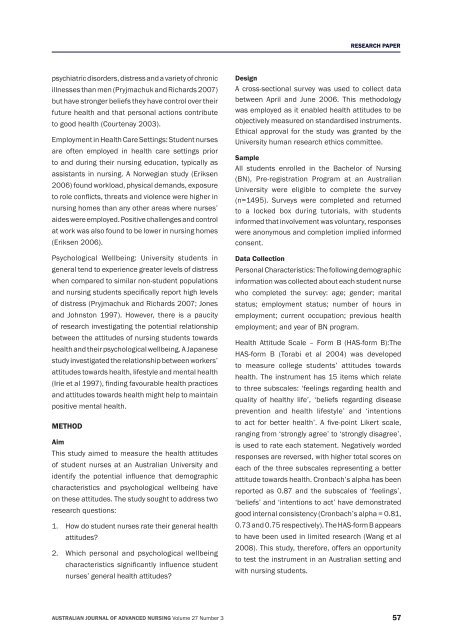March-May, 2010 - Australian Journal of Advanced Nursing
March-May, 2010 - Australian Journal of Advanced Nursing
March-May, 2010 - Australian Journal of Advanced Nursing
Create successful ePaper yourself
Turn your PDF publications into a flip-book with our unique Google optimized e-Paper software.
RESEARCH PAPER<br />
psychiatric disorders, distress and a variety <strong>of</strong> chronic<br />
illnesses than men (Pryjmachuk and Richards 2007)<br />
but have stronger beliefs they have control over their<br />
future health and that personal actions contribute<br />
to good health (Courtenay 2003).<br />
Employment in Health Care Settings: Student nurses<br />
are <strong>of</strong>ten employed in health care settings prior<br />
to and during their nursing education, typically as<br />
assistants in nursing. A Norwegian study (Eriksen<br />
2006) found workload, physical demands, exposure<br />
to role conflicts, threats and violence were higher in<br />
nursing homes than any other areas where nurses’<br />
aides were employed. Positive challenges and control<br />
at work was also found to be lower in nursing homes<br />
(Eriksen 2006).<br />
Psychological Wellbeing: University students in<br />
general tend to experience greater levels <strong>of</strong> distress<br />
when compared to similar non‐student populations<br />
and nursing students specifically report high levels<br />
<strong>of</strong> distress (Pryjmachuk and Richards 2007; Jones<br />
and Johnston 1997). However, there is a paucity<br />
<strong>of</strong> research investigating the potential relationship<br />
between the attitudes <strong>of</strong> nursing students towards<br />
health and their psychological wellbeing. A Japanese<br />
study investigated the relationship between workers’<br />
attitudes towards health, lifestyle and mental health<br />
(Irie et al 1997), finding favourable health practices<br />
and attitudes towards health might help to maintain<br />
positive mental health.<br />
METHOD<br />
Aim<br />
This study aimed to measure the health attitudes<br />
<strong>of</strong> student nurses at an <strong>Australian</strong> University and<br />
identify the potential influence that demographic<br />
characteristics and psychological wellbeing have<br />
on these attitudes. The study sought to address two<br />
research questions:<br />
1. How do student nurses rate their general health<br />
attitudes?<br />
2. Which personal and psychological wellbeing<br />
characteristics significantly influence student<br />
nurses’ general health attitudes?<br />
Design<br />
A cross‐sectional survey was used to collect data<br />
between April and June 2006. This methodology<br />
was employed as it enabled health attitudes to be<br />
objectively measured on standardised instruments.<br />
Ethical approval for the study was granted by the<br />
University human research ethics committee.<br />
Sample<br />
All students enrolled in the Bachelor <strong>of</strong> <strong>Nursing</strong><br />
(BN), Pre‐registration Program at an <strong>Australian</strong><br />
University were eligible to complete the survey<br />
(n=1495). Surveys were completed and returned<br />
to a locked box during tutorials, with students<br />
informed that involvement was voluntary, responses<br />
were anonymous and completion implied informed<br />
consent.<br />
Data Collection<br />
Personal Characteristics: The following demographic<br />
information was collected about each student nurse<br />
who completed the survey: age; gender; marital<br />
status; employment status; number <strong>of</strong> hours in<br />
employment; current occupation; previous health<br />
employment; and year <strong>of</strong> BN program.<br />
Health Attitude Scale – Form B (HAS‐form B):The<br />
HAS‐form B (Torabi et al 2004) was developed<br />
to measure college students’ attitudes towards<br />
health. The instrument has 15 items which relate<br />
to three subscales: ‘feelings regarding health and<br />
quality <strong>of</strong> healthy life’, ‘beliefs regarding disease<br />
prevention and health lifestyle’ and ‘intentions<br />
to act for better health’. A five‐point Likert scale,<br />
ranging from ‘strongly agree’ to ‘strongly disagree’,<br />
is used to rate each statement. Negatively worded<br />
responses are reversed, with higher total scores on<br />
each <strong>of</strong> the three subscales representing a better<br />
attitude towards health. Cronbach’s alpha has been<br />
reported as 0.87 and the subscales <strong>of</strong> ‘feelings’,<br />
‘beliefs’ and ‘intentions to act’ have demonstrated<br />
good internal consistency (Cronbach’s alpha = 0.81,<br />
0.73 and 0.75 respectively). The HAS‐form B appears<br />
to have been used in limited research (Wang et al<br />
2008). This study, therefore, <strong>of</strong>fers an opportunity<br />
to test the instrument in an <strong>Australian</strong> setting and<br />
with nursing students.<br />
AUSTRALIAN JOURNAL OF ADVANCED NURSING Volume 27 Number 3 57

















